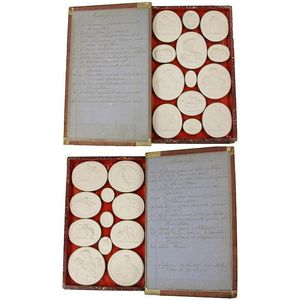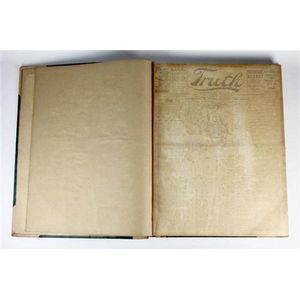Rare Chinese Ivory Panels with Imperial Mark
An extremely rare set of eight Chinese ivory panels, each exquisitely and deeply carved in high relief with mountain scenes (probably taken from scenes in history or mythology). The ivory panels mounted with turquoise pins as pairs in interlocking hardwood box frames, two fashioned as bases the other two as lids. The frames probably of zitan wood, which was reputedly restricted to the use of the Emperors for much of the 18th and 19th centuries. Together with bronze and glazed display stands, removed for display, which are believed to have been made to order prior to Stanton's exodus from China in 1923 (See later notes on Stanton). Each rectangular ivory panel 15 cm x 10 cm, the oval panels 15.5 cm x 10 cm. Each frame 33.5 cm x 11.5 cm. Provenance: The estate of E. A. Stanton. Stanton is recorded as working in Canton (Guangzhou), a partner in the Chinese trading house Deacon & Co., as early as 1908, where the publication 'Twentieth Century Impressions of Hong Kong, Shanghai and Other Treaty Ports of China' noted he conducted the business with a staff of European and Chinese assistants. Curiously, he is recorded with his initials E A, (not his first names) even on a silver punch bowl (sold at an earlier date) celebrating his marriage on April 3rd, 1909. For some period, he was vice consul for Norway in Canton. In 1923 the family relocated to England, subsequently emigrating to New Zealand at a later date. The family took with them the collection of Chinese artifacts gathered during their time in China. On 21st October 2015 the collection of over 50 items, were offered by one of Stanton's descendants at Dunbar Sloane's Auckland auction. Chinese newspapers, used as protective packing for transport to England, confirm the date of departure, for they are dated 11th year of the Republic (1923). Some of these newspapers, now very fragile, remain in situ. Evidence of their earlier existence was also noted by Dunbar Sloane in an insurance valuation dated 1974. In private discussions with the current owner, Dunbar Sloane confirmed that the then current elderly lady owner had been adamant the family tradition was that these ivories had come from the Summer Palace (Yuanming Yuan), destroyed in 1860., Further support for a date of manufacture prior to 1860 however, is to be found on the backs of the upper two boxes, where the very rare Imperial Qianlong Yuzhi mark is painted in gold four character kaishu script. The mark translates as 'Made by Imperial order of the Qianlong Emperor' who reigned from 1736 to 1795, before abdicating in favour of his son, Jiaqing. The Qianlong Emperor is known to have had a great love of the arts, regularly inscribing the best pieces with personalized inscriptions and poetry.
You must be a subscriber, and be logged in to view price and dealer details.
Subscribe Now to view actual auction price for this item
When you subscribe, you have the option of setting the currency in which to display prices to $Au, $US, $NZ or Stg.
This item has been sold, and the description, image and price are for reference purposes only.
- Ivory - Ivory is a hard white material that comes from the tusks of elephants, mammoth, walrus and boar, or from the teeth of hippopotamus and whales. The ivory from the African elephant is the most prized source of ivory. Although the mammoth is extinct, tusks are still being unearthed in Russia and offered for sale.
Ivory has been used since the earliest times as a material for sculpture of small items, both in Europe and the east, principally China and Japan.
In Asia ivory has been carved for netsuke, seals, okimono, card cases, fan supports, animals and other figures and even as carved tusks.
In the last 200 years in Europe ivory has been used to carve figures, for elaborate tankards, snuff boxes, cane handles, embroidery and sewing accessories, in jewellery and as inlay on furniture. Its more practical uses include being used for billiard balls, buttons, and a veneers on the top of piano keys.
The use and trade of elephant ivory have become controversial because they have contributed to Due to the decline in elephant populations because of the trade in ivory, the Asian elephant was placed on Appendix One of the Convention on International Trade in Endangered Species (CITES), in 1975, and in January 1990, the African elephant was similarly listed. Under Appendix One, international trade in Asian or African elephant ivory between member countries is forbidden. Unlike trade in elephant tusks, trade in mammoth tusks is legal.
Since the invention of plastics, there have been many attempts to create an artificial ivory - Bronze - An alloy of copper and tin, traditionally in the proportions of about 9 parts of copper to 1 part of tin.
The discovery of bronze in Western Asia in the 4th century enabled people to create metal objects which were superior to those previoulsy possible because of its strength and hardness, and it has been used throughout the world for weapons, coins, tools, statuary and other decorative items.
It is very fluid in a molten state, and its hardness, strength when set, and non-corrosive properties makes it most suitable for casting sculpture.
This item has been included into following indexes:
Visually similar items

Convict Bricks consisting of ten in total with varying frogs
Sold by
in
for
You can display prices in $Au, $US, $NZ or Stg.

Victorian plaster casts in book form case totalling twenty four plaques
Sold by
in
for
You can display prices in $Au, $US, $NZ or Stg.

An Indo-Persian hand knotted carpet, the field decorated with lotus tendrils in ivory on a dark ground, framed by a stylised lotus border. 310 cm x 243 cm
Sold by
in
for
You can display prices in $Au, $US, $NZ or Stg.

Newcastle edition 'Truth' Newspapers dated 1920 dating from January 4th December 26th, length 62 cm
Sold by
in
for
You can display prices in $Au, $US, $NZ or Stg.
